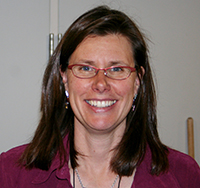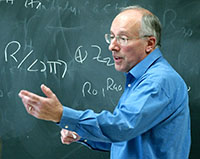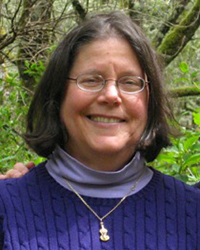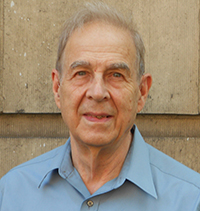- About MAA
- Membership
- MAA Publications
- Periodicals
- Blogs
- MAA Book Series
- MAA Press (an imprint of the AMS)
- MAA Notes
- MAA Reviews
- Mathematical Communication
- Information for Libraries
- Author Resources
- Advertise with MAA
- Meetings
- Competitions
- Programs
- Communities
- MAA Sections
- SIGMAA
- MAA Connect
- Students
- MAA Awards
- Awards Booklets
- Writing Awards
- Teaching Awards
- Service Awards
- Research Awards
- Lecture Awards
- Putnam Competition Individual and Team Winners
- D. E. Shaw Group AMC 8 Awards & Certificates
- Maryam Mirzakhani AMC 10 A Awards & Certificates
- Two Sigma AMC 10 B Awards & Certificates
- Jane Street AMC 12 A Awards & Certificates
- Akamai AMC 12 B Awards & Certificates
- High School Teachers
- News
You are here
Invited Addresses
Earle Raymond Hedrick Lecture Series
Bjorn Poonen, Massachusetts Institute of Technology
 Undecidability in Number Theory
Undecidability in Number Theory
Thursday, August 7, 10:30 a.m. - 11:20 a.m., Hilton Portland, Ballroom Level, Grand Ballroom
Undecidability in Analysis and Topology
Friday, August 8, 9:30 a.m. - 10:20 a.m., Hilton Portland, Ballroom Level, Grand Ballroom
Undecidability Everywhere
Saturday, August 9, 9:30 a.m. - 10:20 a.m., Hilton Portland, Ballroom Level, Grand Ballroom
Hilbert's Tenth Problem asked for an algorithm that, given a multivariable polynomial equation with integer coefficients, would decide whether there exists a solution in integers. Around 1970, Matiyasevich, building on earlier work of Davis, Putnam, and Robinson, showed that no such algorithm exists. But the answer to the analogous question with integers replaced by rational numbers is still unknown, and there is not even agreement among experts as to what the answer should be. Meanwhile, over the past decades, many problems in areas of mathematics other than number theory have also been found to be undecidable. I will present a sampling of these, and discuss a few problems whose undecidability status is not yet known.
Biography: Bjorn Poonen is the Claude Shannon Professor of Mathematics at The Massachusetts Institute of Technology (MIT). He received A.B. and Ph.D. degrees from Harvard and Berkeley, respectively, and held positions at MSRI, Princeton, and Berkeley before moving to MIT in 2008. Poonen's research focuses mainly on number theory and algebraic geometry; in particular, he is interested in the rational number solutions to equations. Poonen is the founding managing editor of Algebra & Number Theory. He is a fellow of the American Academy of Arts and Sciences and of the American Mathematical Society. He has received the Guggenheim, Packard, Rosenbaum, and Sloan fellowships, as well as a Miller Professorship and the 2011 Chauvenet Prize. Earlier, he was a four-time Putnam Competition winner, an International Mathematical Olympiad medalist, and the unique perfect scorer out of 385,000 participants in the 1985 American High School Mathematics Exam. Fifteen mathematicians have completed a Ph.D. thesis under his guidance.
AMS-MAA Joint Invited Address
What is the Value of a Computer Proof in Research and Teaching?
Friday, August 8, 10:30 a.m. - 11:20 a.m., Hilton Portland, Ballroom Level, Grand Ballroom
Sara Billey, University of Washington

Biography: Sara C. Billey is Professor of Mathematics at the University of Washington. She earned her undergraduate degree at MIT and went on to study mathematics at the University of California in San Diego, where she earned MA and PhD degrees in mathematics. Profesor Billey’s research specialty is combinatorics. She is known for her contributions on Schubert polynomials, singular loci of Schubert varieties, Kostant polynomials, Kazhdan–Lusztig polynomials often using computer verified proofs. She is a strong advocate of using computers to do research in mathematics, in particular for obtaining data for conjectures and computer verified proofs.
In 2000 Professor Billey received the Presidential Early Career Award for Scientists and Engineers (PECASE). She has also been the recipient of an NSF Career award. In 2012 she became a fellow of the American Mathematical Society.
For more information on Professor Billey, see the delightful prize-winning essay The Most Famous Sara in Mathematics by Rebecca Myers.
MAA Invited Address
Understanding Microorganism Swimming using Mathematics
Thursday, August 7, 9:30 a.m. - 10:20 a.m., Hilton Portland, Ballroom Level, Grand Ballroom
Ricardo Cortez, Tulane University
 Biological fluid flows, like those surrounding moving bacteria and spermatozoa, are generated by viscous forces, which completely dominate inertial effects, so that their dynamics may be modeled as a sequence of steady-state snapshots. Microorganism motility has been an active area of research for the last 60 years motivated by questions like: What are effective locomotion strategies of microorganisms? How do they interact with the surrounding environment? How do microorganisms combine to create patterns of collective motion? What force-generating mechanisms do the organisms use to propel themselves? The only way to answer these questions is through a combination of theory, experiments, mathematical modeling and simulation. We will present recent collaborative mathematical work, some of it done with undergraduate students, that sheds light on these biological systems and challenges ahead.
Biological fluid flows, like those surrounding moving bacteria and spermatozoa, are generated by viscous forces, which completely dominate inertial effects, so that their dynamics may be modeled as a sequence of steady-state snapshots. Microorganism motility has been an active area of research for the last 60 years motivated by questions like: What are effective locomotion strategies of microorganisms? How do they interact with the surrounding environment? How do microorganisms combine to create patterns of collective motion? What force-generating mechanisms do the organisms use to propel themselves? The only way to answer these questions is through a combination of theory, experiments, mathematical modeling and simulation. We will present recent collaborative mathematical work, some of it done with undergraduate students, that sheds light on these biological systems and challenges ahead.
Biography: Ricardo Cortez received a B.A. in mathematics and a B.S. in mechanical engineering from Arizona State University. He earned a Ph.D. in applied mathematics from the University of California at Berkeley in 1995 and became an NSF postdoctoral fellow and Courant Instructor at New York University. He joined the faculty at Tulane University in 1998, where he is the Pendergraft William Larkin Duren Professor of Mathematics and Director of the Center for Computational Science. Prof. Cortez was the 2012 recipient of the Blackwell-Tapia prize for significant contributions to research and for serving as a role model for mathematical scientists and students from underrepresented minority groups. His research interests include computational mathematics, mathematical biology, modeling, and secondary mathematics education.
MAA Invited Address
Mathematical Models of the Retina and In Silico Experiments: Shedding Light on Vision Loss
Saturday, August 9, 10:30 a.m. - 11:20 a.m., Hilton Portland, Ballroom Level, Grand Ballroom
Erika Camacho, Massachusetts Institute of Technology and Arizona State University
 Mathematical modeling has been used to study diverse biological topics ranging from protein folding to cell interactions to interacting populations of humans but has only recently been used to study the physiology of the eye. In recent years, computer (in silico) experiments have given researchers invaluable insights and in some cases have re-directed experimental research and theory. In this talk I will give a brief overview of the relevant physiology of the eye as it pertains to Retinitis pigmentosa (RP), a group of inherited degenerative eye diseases that characterized by the premature death of both rod and cone photoreceptors often resulting in total blindness. With mathematics and in silico experiments, we explore the experimentally observed results highlighting the delicate balance between the availability of nutrients and the rates of shedding and renewal of photoreceptors needed for a normal functioning retina. This work provides a framework for future physiological investigations potentially leading to long-term targeted multi-faceted interventions and therapies dependent on the particular stage and subtype of RP under consideration. The mathematics presented will be accessible to an undergraduate math audience and the biology will be at the level of a novice (and with a little help from Dr. Seuss).
Mathematical modeling has been used to study diverse biological topics ranging from protein folding to cell interactions to interacting populations of humans but has only recently been used to study the physiology of the eye. In recent years, computer (in silico) experiments have given researchers invaluable insights and in some cases have re-directed experimental research and theory. In this talk I will give a brief overview of the relevant physiology of the eye as it pertains to Retinitis pigmentosa (RP), a group of inherited degenerative eye diseases that characterized by the premature death of both rod and cone photoreceptors often resulting in total blindness. With mathematics and in silico experiments, we explore the experimentally observed results highlighting the delicate balance between the availability of nutrients and the rates of shedding and renewal of photoreceptors needed for a normal functioning retina. This work provides a framework for future physiological investigations potentially leading to long-term targeted multi-faceted interventions and therapies dependent on the particular stage and subtype of RP under consideration. The mathematics presented will be accessible to an undergraduate math audience and the biology will be at the level of a novice (and with a little help from Dr. Seuss).
Biography: Erika Tatiana Camacho grew up in East Los Angeles and was taught by Jaime Escalante at Garfield High School. She received her Ph.D. in Applied Mathematics from Cornell University. She has held positions at Los Alamos National Laboratory, Loyola Marymount University, and ASU. She is currently an MLK Visiting Assistant Professor of Mathematics at Massachusetts Institute of Technology (MIT). ). She co-founded and co-directed the Applied Mathematical Sciences Summer Institute (AMSSI), dedicated to the recruitment of undergraduate women, underrepresented minorities, and those that might not otherwise have the opportunity. Her current research is at the interface of mathematics, biology, physiology, and sociology and involves mathematically modeling degenerative eye diseases, gene networks within yeast, social networks, alcohol effects on a neuron firing, and fungal resistance under selective pressure. Her leadership, scholarship, and mentoring has won her national recognition including the SACNAS Distinguished Undergraduate Mentoring Award in 2012 and the National Hispanic Women Corporation Latina Leadership Award in 2011, recognition as one of 12 Emerging Scholars of 2010 by Diverse: Issues in Higher Education, and a citation for mentoring and guiding undergraduates in research by the U.S. National Security Agency. Some of her local recognitions include the Dr. Manuel Servin Faculty Award for excellence in exemplifying achievement in research, mentorship of Hispanic students, leadership at ASU and in the community in 2013, the New College of Interdisciplinary Arts and Sciences Faculty Service Award in 2013, the 40 Hispanic Leaders Under 40 Award in 2012 and the ASU Faculty Women’s Association Outstanding Faculty Mentor Award in 2011.
MAA Invited Address
First Person Solvers – Using Video Games to Learn Mathematics and Solve Real Math Problems
Thursday, August 7, 8:30 a.m. - 9:20 a.m., Hilton Portland, Ballroom Level, Grand Ballroom
Keith Devlin, Stanford University
 The design of a good interface to an activity can have a significant impact on learning and use. The piano provides a more intuitive and direct interface to music than symbolic musical notation, the Hindu-Arabic numerals revolutionized arithmetic (and with it, trade and commerce), and symbolic algebraic notation was so successful that most people today think the interface is algebra, rather than the mathematical processes the notation represents. Devlin has spent the past several years developing casual games that provide representations of mathematics that enable children (and adults) to learn basic mathematics by "playing", the same way we can learn music by learning to play the piano.
The design of a good interface to an activity can have a significant impact on learning and use. The piano provides a more intuitive and direct interface to music than symbolic musical notation, the Hindu-Arabic numerals revolutionized arithmetic (and with it, trade and commerce), and symbolic algebraic notation was so successful that most people today think the interface is algebra, rather than the mathematical processes the notation represents. Devlin has spent the past several years developing casual games that provide representations of mathematics that enable children (and adults) to learn basic mathematics by "playing", the same way we can learn music by learning to play the piano.
Biography: Keith Devlin is a co-founder and Executive Director of the university's H-STAR institute, a co-founder of the Stanford Media X research network, and a Senior Researcher at CSLI. He is a World Economic Forum Fellow, a Fellow of the American Association for the Advancement of Science, and a Fellow of the American Mathematical Society. His current research is focused on the use of different media to teach and communicate mathematics to diverse audiences. In this connection, he is a co-founder and President of an educational video games company, InnerTube Games. He also works on the design of information/reasoning systems for intelligence analysis. Other research interests include: theory of information, models of reasoning, applications of mathematical techniques in the study of communication, and mathematical cognition. He has written 32 books and over 80 published research articles. Recipient of the Pythagoras Prize, the Peano Prize, the Carl Sagan Award, and the Joint Policy Board for Mathematics Communications Award. In 2003, he was recognized by the California State Assembly for his "innovative work and longtime service in the field of mathematics and its relation to logic and linguistics." He is "the Math Guy" on National Public Radio.
James R. C. Leitzel Lecture
Research in Mathematics by Undergraduates: Past, Present, and Future
Saturday, August 9, 8:30 a.m. - 9:20 a.m., Hilton Portland, Ballroom Level, Grand Ballroom
Joseph Gallian, University of Minnesota Duluth
 Although involving undergraduates in research has been a long standing practice in the experimental sciences, it has only been recently that undergraduates have been involved in research in mathematics in significant numbers. In this talk I will trace the evolution of research by undergraduates over the past 25 years and the reasons for it. I will give my opinion on what lies ahead over the next ten years.
Although involving undergraduates in research has been a long standing practice in the experimental sciences, it has only been recently that undergraduates have been involved in research in mathematics in significant numbers. In this talk I will trace the evolution of research by undergraduates over the past 25 years and the reasons for it. I will give my opinion on what lies ahead over the next ten years.
Biography: Joe Gallian received a PhD from Notre Dame in 1971. He has been at the University of Minnesota Duluth since 1972. He is the author of the book "Contemporary Abstract Algebra" (8th edition) and coauthor of the book "For All Practical Purposes" (9th edition). His research interests include groups, graphs and combinatorics. He has published more than 100 articles and given over 250 invited lectures at colleges, universities and conferences. He has directed summer research programs for undergraduate students since 1977. Over 200 papers written in the program have been published in professional-level research journals. Ten program alumni have received the AMS-MAA-SIAM Morgan Prize for research, 14 have won the Association for Women Alice Schafer Prize, and one hundred and fifteen have received a PhD degree. He has received teaching awards from the Mathematical Association of America, the Carnegie Foundation and the University of Minnesota. He is past President of the Mathematical Association of America and a Fellow of the American Mathematical Society.
AWM-MAA Etta Z. Falconer Lecture
From Algebraic to Weak Subintegral Extensions in Algebra and Geometry
Friday, August 8, 8:30 a.m. - 9:20 a.m., Hilton Portland, Ballroom Level, Grand Ballroom
Marie A. Vitulli, University of Oregon
 As students of algebra we quickly learn that for the purpose of solving polynomial equations the field of rational numbers is inadequate. We soon become acquainted with algebraic extensions of the rationals and later in our studies meet the fields of algebraic numbers, real numbers, and complex numbers, the latter as the algebraic closure of the real field.
As students of algebra we quickly learn that for the purpose of solving polynomial equations the field of rational numbers is inadequate. We soon become acquainted with algebraic extensions of the rationals and later in our studies meet the fields of algebraic numbers, real numbers, and complex numbers, the latter as the algebraic closure of the real field.
As students of commutative algebra we learn about integral extensions of rings and their properties and consequences in the study of algebraic varieties and schemes. Again, for some purposes, integral extensions do not accomplish all that we had hoped for. Much more recently geometers and algebraists introduced the twin theories of weak normality and seminormality for commutative rings and algebraic varieties to address some of these deficiencies.
In this talk we outline the history of the twin theories with an emphasis on the recent developments in the area over the past fifteen years. For clarity of exposition we will focus our attention on the characteristic 0 case where the theories merge into one.
Biography: Marie A. Vitulli is Professor Emerita of Mathematics at the University of Oregon. She received her B.A. degree with highest distinction from the University of Rochester and her M.A. and Ph.D. degrees from the University of Pennsylvania. Upon completing the Ph.D. degree Dr. Vitulli joined the faculty at the University of Oregon and remained there for her entire academic career. Dr. Vitulli has made original and important contributions to commutative algebra and its interactions with algebraic geometry. Over her long career she has worked tirelessly for the advancement of women in mathematics. Prof. Vitulli has published numerous research articles and book chapters and has lectured on her work throughout the United States, Europe, and South Africa.
After her early work in deformation theory Vitulli turned her attention to the study of seminormality and weak normality for commutative rings and algebraic varieties. In a series of papers with her colleague John V. Leahy, she developed fundamental properties of seminormality and made connections to the theory of weakly normal complex analytic spaces. More recently Vitulli discovered an elegant new element-wise criterion for weak subintegrality. Along with her colleague D.K. Harrison, she developed a unified valuation theory for rings with zero divisors that generalized both Krull and Archimedean valuations.
While at Oregon, Dr. Vitulli worked in many ways to improve opportunities for women in mathematics. She was involved in the creation and administration of a scholarship program for undergraduate women in mathematics and the physical sciences. Professor Vitulli created and maintains the award-winning website Women in Math Web Project.
Pi Mu Epsilon J. Sutherland Frame Lecture
Fibonacci and the First Personal Computing Revolution
Friday, August 8, 8:00 p.m. - 8:50 p.m., Hilton Portland, Ballroom Level, Grand Ballroom
Keith Devlin, Stanford University
 The first personal computing revolution took place not in Silicon Valley in the 1980s but in Pisa in the 13th Century. The medieval counterpart to Steve Jobs was a young Italian called Leonardo, better known today by the nickname Fibonacci. Thanks to a recently discovered manuscript in a library in Florence, the story of how this genius, about whom we know so little, came to launch the modern commercial world can now be told.
The first personal computing revolution took place not in Silicon Valley in the 1980s but in Pisa in the 13th Century. The medieval counterpart to Steve Jobs was a young Italian called Leonardo, better known today by the nickname Fibonacci. Thanks to a recently discovered manuscript in a library in Florence, the story of how this genius, about whom we know so little, came to launch the modern commercial world can now be told.
Based on Devlin’s book The Man of Numbers: Fibonacci’s Arithmetical Revolution (Walker & Co, July 2011) and his co-published companion e-book Leonardo and Steve: The Young Genius Who Beat Apple to Market by 800 Years.
Biography: Keith Devlin is a co-founder and Executive Director of the university's H-STAR institute, a co-founder of the Stanford Media X research network, and a Senior Researcher at CSLI. He is a World Economic Forum Fellow, a Fellow of the American Association for the Advancement of Science, and a Fellow of the American Mathematical Society. His current research is focused on the use of different media to teach and communicate mathematics to diverse audiences. In this connection, he is a co-founder and President of an educational video games company, InnerTube Games. He also works on the design of information/reasoning systems for intelligence analysis. Other research interests include: theory of information, models of reasoning, applications of mathematical techniques in the study of communication, and mathematical cognition. He has written 32 books and over 80 published research articles. Recipient of the Pythagoras Prize, the Peano Prize, the Carl Sagan Award, and the Joint Policy Board for Mathematics Communications Award. In 2003, he was recognized by the California State Assembly for his "innovative work and longtime service in the field of mathematics and its relation to logic and linguistics." He is "the Math Guy" on National Public Radio.
The Jean Bee Chan and Peter Stanek Lecture for Students
The Founding of Pi Mu Epsilon 100 Years Ago

Thursday, August 7, 1:00 p.m. - 1:50 p.m., Hilton Portland, Ballroom Level, Grand Ballroom I
Jack Graver, Syracuse University
On December 8, 1913 the Mathematical Club of Syracuse University met on the 10th anniversary of it’s founding. “Miss Florence Richert presented the paper ‘The Evaluation and Transcendence of Pi.’ Discussion followed the reading of the paper.” There was a short business meeting before refreshments at which “Dr. Roe gave the report of committee appointed to consider changing the Club into a Mathematical Fraternity.” The decision was made to proceed with this project and during the Spring semester of 1914 the details were worked out and PME was incorporated in New York State.
What did they want to accomplish by taking this action? What was background against which the decision to found PME was made? Using the Archives of Syracuse University and the detailed notes left by the founders, I hope to answer these questions and to develop an understanding of the historical context in which PME was born.

NAM David Harold Blackwell Lecture
Markov Decision Processes, Turnpike Horizons and Blackwell Optimality
Friday, August 8, 1:00 p.m. - 1:50 p.m., Hilton Portland, Ballroom Level, Grand Ballroom I
Mark Lewis, Cornell University
A Markov decision process (MDP) is defined by the 5-tuple: the time horizon, a state space, a transition matrix (of a Markov chain), a control or action space, and a cost or reward function. Together, this constitutes a mathematical construct for optimizing dynamic decision-making under uncertainty. In this talk, we outline the components of an MDP, discuss classic results of Blackwell, then show how Blackwell's optimality criterion can be used in controlled queueing systems and for the development of turnpike horizons.
Martin Gardner Centennial Lecture
The Magic of Martin Gardner
Saturday, August 9, 2:30 p.m. - 3:20 p.m., Hilton Portland, Ballroom Level, Grand Ballroom
Persi Diaconis, Stanford University

Martin Gardner somehow managed to make mathematical ideas come alive to the broadest spectrum, from runaway teenagers to homemakers to professional mathematicians. The question is "How did he do it?" Along the way he exposed fake mediums, elucidated Alice in Wonderland, wrote awful poetry, and explained magic tricks. One recurrent theme in his writing: He thought that tricks, riddles, and jokes should be woven into our teaching. Neither the education establishment nor the upper crust of mathematicians seems to agree. I'll try to bring all of this to life. But, beware, as someone once wrote:
"Warning: Martin Gardner has caused dozens of innocent youngsters to become professional mathematicians and thousands of professional mathematicians to become innocent youngsters."
This event is free and open to the public.
Year:
2014




